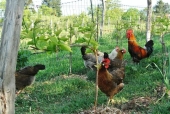posted 11 years ago
Hello. I would like to ask advice for use of a small small area on our farm that we are not using for anything at the moment. It was partly cleared with machinery of some of the rocks about 5 years ago, but it is not level enough to be harvested by machine. A neighbor's sheep have been grazing, so what grows there now is wild grasses, no much that is larger. Exept for some holly and alder at the margins. Ideally I would have cleared the rocks and leveled the field and sown some mixture of grass and clovers that would be suitable for grazing and for making hay. This is the normal thing around here. Other plants like trees or bushes (fodder and fruit) would also be possible to plant. But the problem is that I will probably not have the time or opportunity to do this before spring this year (either). And we really should use the area, to save on winter feed, which we have had to buy until now. We have three jersey cows and a calf.
Some information about the land: The size of the plot is approximately 2-4 dekar (0,5 - 1 acre), it is sloping to the north. Possible frost from October to April, but this winter we have hardly had any frost or snow at all. Mild coastal climate, south west coast of Norway, northern Europe. About 70 meters above sea level, close to the fjord and just underneath the mountains. It is quite wet all year round here. I see a lot of people at Permies are concerned about keeping the water and making swales and things, but here it is normally more important to get rid of the water than to retain it. The soil is also quite shallow over the bedrock, so the water doesn't escape down in the ground. (Maybe a system of ponds would be useful.)
I was wondering, for the short term, if there was a fodder plant that could be sown or planted in the existing grass and that could be harvested reasonably easy by hand and dried for use in the cold season. I just read there are some trials of quinoa here in Norway, with seeds that are now adapted to our climate. Those plants are quite large, and could be harvested by hand (one plant at a time) easier than if the same area was sown with grasses, I imagine. But is quinoa usable as a fodder plant? I read it has saponins. It would not need threshing as long as it is for fodder, I believe. And its close relative amaranth, is that a possibility? What about peas or other legumes, or some bushing old grain varieties? Mixtures of the above? I am thinking annual plants now, but if I don't get around to cultivate the area next year either, maybe perennials may be the right thing.
I hope that in some years we find a long term use of this area. Maybe something along agroforestry lines with fruit or nuts in rows (apples, plums, hazelnuts, walnuts etc.) and grazing and haymaking in between. Fruit could be harvested in nets and collected at the bottom of the slope. The rest of our farm is about 28 daa (7 acres) pasture and 50 daa (12 acres) mixed forest that slopes up to the mountain. In addition to the cows we also have hens (although our neighbors the fox and the hawk visit from time to time and make the egg supply unstable). We have used pigs for clearing fields for new sowing, but now we want to take a break from having pigs. We make our living by making the products of the farm into organic ice cream.
I am grateful for all input both on short term and long term use of this fallow plot.
Kind regards
Øystein S.










